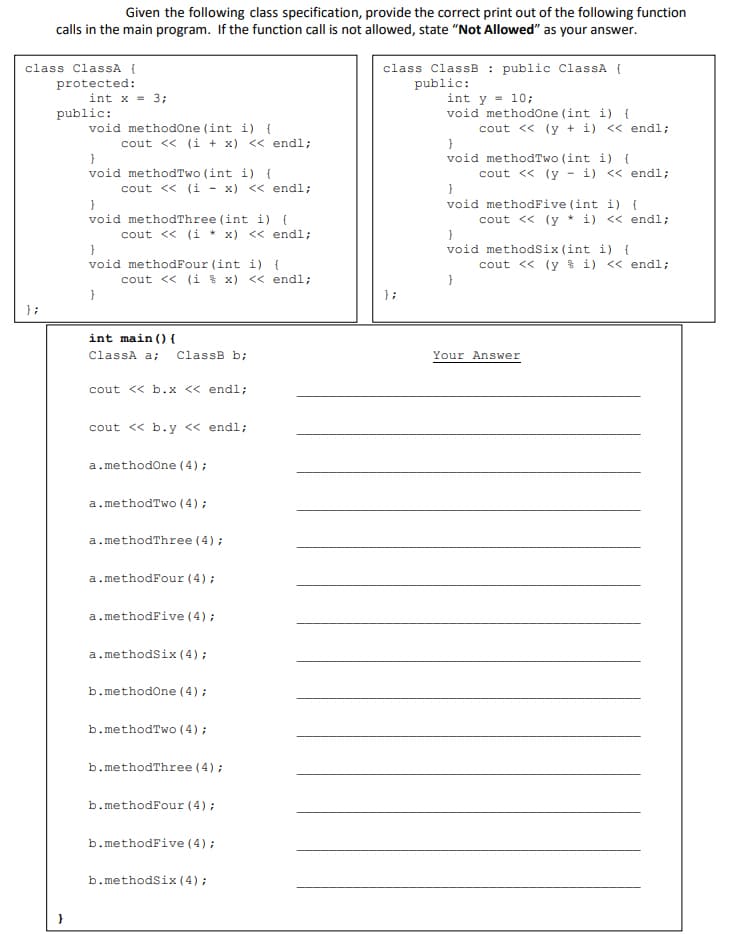Given the following class specification, provide the correct print out of the following function calls in the main program. If the function call is not allowed, state "Not Allowed" as your answer. class ClassA { class ClassB : public ClassA { public: int y = 10; void methodone (int i) { cout « (y + i) « endl; protected: int x = 3; public: void methodone (int i) { cout « (i + x) « endl; void methodTwo (int i) { void methodTwo (int i) { cout « (y - i) « endl; cout « (i - x) « endl; void methodFive (int i) { cout <« (y i) « endl; void methodThree (int i) { cout << (i x) << endl; void methodsix (int i) { cout « (y % i) « endl; void methodFour (int i) { cout <« (i x) <« endl; << }; }; int main () { ClassA a; ClassB b; Your Answer cout « b.x <« endl; cout « b.y <« endl; a.methodone (4); a.methodTwo (4); a.methodThree (4); a.methodFour (4); a.methodFive (4); a.methodsix (4); b.methodone (4); b.methodTwo (4); b.methodThree (4); b.methodFour (4); b.methodFive (4); b.methodSix (4);
Given the following class specification, provide the correct print out of the following function calls in the main program. If the function call is not allowed, state "Not Allowed" as your answer. class ClassA { class ClassB : public ClassA { public: int y = 10; void methodone (int i) { cout « (y + i) « endl; protected: int x = 3; public: void methodone (int i) { cout « (i + x) « endl; void methodTwo (int i) { void methodTwo (int i) { cout « (y - i) « endl; cout « (i - x) « endl; void methodFive (int i) { cout <« (y i) « endl; void methodThree (int i) { cout << (i x) << endl; void methodsix (int i) { cout « (y % i) « endl; void methodFour (int i) { cout <« (i x) <« endl; << }; }; int main () { ClassA a; ClassB b; Your Answer cout « b.x <« endl; cout « b.y <« endl; a.methodone (4); a.methodTwo (4); a.methodThree (4); a.methodFour (4); a.methodFive (4); a.methodsix (4); b.methodone (4); b.methodTwo (4); b.methodThree (4); b.methodFour (4); b.methodFive (4); b.methodSix (4);
C++ Programming: From Problem Analysis to Program Design
8th Edition
ISBN:9781337102087
Author:D. S. Malik
Publisher:D. S. Malik
Chapter10: Classes And Data Abstraction
Section: Chapter Questions
Problem 10SA:
Consider the definition of the class product Type as given in Exercise 8.
Answer the following...
Related questions
Question

Transcribed Image Text:Given the following class specification, provide the correct print out of the following function
calls in the main program. If the function call is not allowed, state "Not Allowed" as your answer.
class ClassA {
class ClassB : public ClassA {
protected:
int x - 3;
public:
void methodOne (int i) {
cout << (i + x) << endl;
public:
int y = 10;
void methodOne (int i) {
cout << (y + i) << endl;
}
void methodTwo (int i) {
cout << (y - i) << endl;
void methodTwo (int i) {
cout <« (i - x) << endl;
}
void methodFive (int i) {
cout << (y * i) << endl;
}
void methodsix (int i) {
cout << (y % i) << endl;
}
void methodThree (int i) {
cout << (i * x) << endl;
void methodFour (int i) {
cout << (i % x) << endl;
} ;
} ;
int main () {
ClassA a;
ClassB b;
Your Answer
cout << b.x << endl;
cout << b.y << endl;
a.methodone (4);
a.methodTwo (4);
a.methodThree (4);
a.methodFour (4);
a.methodFive (4);
a.methodsix (4);
b.methodone (4);
b.methodTwo (4);
b.methodThree (4);
b.methodFour (4);
b.methodFive (4);
b.methodsix (4);
Expert Solution
This question has been solved!
Explore an expertly crafted, step-by-step solution for a thorough understanding of key concepts.
This is a popular solution!
Trending now
This is a popular solution!
Step by step
Solved in 2 steps

Knowledge Booster
Learn more about
Need a deep-dive on the concept behind this application? Look no further. Learn more about this topic, computer-science and related others by exploring similar questions and additional content below.Recommended textbooks for you

C++ Programming: From Problem Analysis to Program…
Computer Science
ISBN:
9781337102087
Author:
D. S. Malik
Publisher:
Cengage Learning

C++ for Engineers and Scientists
Computer Science
ISBN:
9781133187844
Author:
Bronson, Gary J.
Publisher:
Course Technology Ptr

C++ Programming: From Problem Analysis to Program…
Computer Science
ISBN:
9781337102087
Author:
D. S. Malik
Publisher:
Cengage Learning

C++ for Engineers and Scientists
Computer Science
ISBN:
9781133187844
Author:
Bronson, Gary J.
Publisher:
Course Technology Ptr